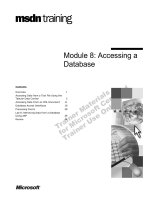Tài liệu Customer Relationship Management: A Database Approach - Class 6 pptx
Bạn đang xem bản rút gọn của tài liệu. Xem và tải ngay bản đầy đủ của tài liệu tại đây (1.08 MB, 20 trang )
Customer Relationship Management:
A Database Approach
MARK 7397
Spring 2007
James D. Hess
C.T. Bauer Professor of Marketing Science
375H Melcher Hall
713 743-4175
Class 6
•
Computation of Customer Profitability
•
Past Customer Value of a customer
Where i = number representing the customer, r = applicable discount rate
n = number of time periods prior to current period when purchase was made
GC
in
= Gross Contribution of transaction of the i
th
customer in the n
th
time period
•
Since products/services are bought at different points in time during the customer’s
lifetime, all transactions have to be adjusted for the time value of money
•
Limitations: Does not consider whether a customer is going to be active in the future.
Also does not incorporate the expected cost of maintaining the customer in the future
Past Customer Value
∑
=
+=
N
1n
n
in
)r1(*GC
Spending Pattern of a Customer
The above customer is worth $302.01 in contribution margin, expressed in net present
value in May dollars. By comparing this score among a set of customers a prioritization
is arrived at for directing future marketing efforts
Jan Feb March April May
$ Amount 800 50 50 30 20
GC 240 15 15 9 6
302.01486
5
)0125.01(240
4
)0125.01(15
3
)0125.01(15
2
)0125.01(9)0125.01(6
Scoring ValueCustomer Past
0.3 Amount X Purchase (GC) Contribution Gross
=++++
+++++
=
´=
Lifetime Value metrics
(Net Present Value models)
•
Multi-period evaluation of a customer’s value to the firm
Recurring
Revenues
Recurring
costs
Contribution
margin
Lifetime of a
customer
Lifetime Profit
Acquisition
cost
LTV
Discount
rate
Calculation of Lifetime Value: Simple Definition
where LTV = lifetime value of an individual customer in $, CM = contribution
margin, δ = interest rate, Rr = retention rate, so Rr
t
=survival rate for t periods
•
LTV is a measure of a single customer’s worth to the firm
•
Used for pedagogical and conceptual purposes
t
T
1t
t
1
Rr
CMLTV
∑
=
δ+
=
CM1
CM2
Rr
t
1/(1+δ)
t
0
LTV: Definition Accounting for
Acquisition Cost and Retention Probabilities
Where, LTV = lifetime value of an individual customer in $
Rr
k
= retention rate
П = Product of retention rates for each time period from 1 to T,
AC = acquisition cost
T = total time horizon under consideration
Assuming that T ∞ and that the contribution margin CM does not vary over time,
ACCMRrLTV
T
t
it
t
k
−
+
=
∑
∏
=
=
1
1
1
1
δ
t
k
AC
Rr
CM
i
LTV
i
−
+−
=
δ
1
Rr
Note: many typos on page 127
To Calculate Customer Lifetime Value
1. You must be able to forecast profit contributions
2. You must understand the cost of marketing
3. You must be able to forecast retention rates of customers
(since if the customer has abandoned the firm no profits
will flow.)
4. It is possible that customers will “churn.” That is, they may leave
and then return later.
5. The contribution of a customer may be causally tied to churn and
abandonment, making this trickier than it looks.
6. You need to understand NPV calculations.
LTV: Definition Accounting for
Varying Levels of Contribution Margin
Where, LTV = lifetime value of an individual customer i in $, S =
Sales to customer i, DC = direct cost of products purchased by
customer i, MC = marketing cost of customer i
t
T
1t
ititit
1
1
MCDCSLTV
∑
=
δ+
−−=









